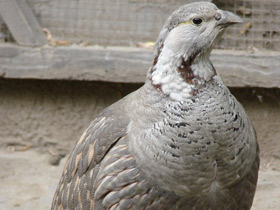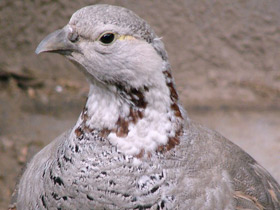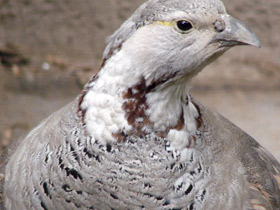The Himalayan snowcock Tetraogallus himalayensis
The Himalayan snowcock is a large bird (the male’s weight may reach 3.6 kg) slightly resembling a turkey. Contrary to many other galliforms, Himalayan snowcocks have quite dull plumage, similar in males and females. Adult birds’ rump and wing feathers, as well as tail feather coverts are generally grey with horizontal blackish streaking. The head is ash grey, the throat and neck are white, fringed with rufous brown stripe. The crop is creamy, spotted with black. A dark moustachial stripe extends down to the hindneck and joins the collar. The belly is darker grey-brown, with streaking pattern. The mantle is slightly paler grey. The white tipped-black primaries are visible in flight, as are the rufous outer tail feathers. Legs and feet are dark orange-yellow. The male has spurs on the legs.
The Himalayan Snowcock is native to Asia, ranging across Tian Shen to the Southern Altai Mountains. It is found at elevations of 1,000 to 5,000 meters in the Jungar and Zaili Alatau Mountains. Himalayan snowcocks are also seen in alpine and subalpine pastures and rocky ridges. In winter with high snow cover, the birds migrate down to elevations of 1,500–2000 meters, staying in the leeside on snow-free slops. These birds prefer open steep valleys with rocky outcrops at very high elevation. They usually walk when moving uphill and glide downwards (with the altitude difference of 400 m over the distance of 1,500 m), sometimes flapping their wings to slow down. Being a hardy walker and fast runner, the Himalayan snowcock is perfectly adapted to alpine landscapes.
Outside the breeding season, Himalayan snowcocks stay in flocks of 10–15 birds, flying to lower altitudes in the morning and walking slowly uphill during the day, foraging on grassy areas en route. They spend nighttime on inaccessible ledges or in the caves. In March, the flocks split up into pairs, and the males start their courtship display; the male crouches down to the ground with his wings fanned, the tail feathers dropped and the plumage slightly ruffled. Territorial conflicts may occur between males along the boundaries of the birds’ home ranges. The female builds a nest on the ground. The nest is a simple depression lined with dry grasses and feathers, built amongst tussocks of grass and often protected by rock or boulder; sometimes the nests are built in the caves. The female lays six (sometimes up to 16) greenish-blue eggs. She incubates the clutch with high constancy during a month. The males sometimes participate in brood rearing but more often migrate to the moulting grounds where they stay for 5–5.5 months. In mid-summer, the broods usually move to higher altitudes, following the wave of rich vegetation and in August, descend to lower zones where broods may form brood flocks. Congregations of hundreds and even thousands of birds are seen in some places in winter. Himalayan snowcocks are shy birds, but their calls can be heard at a large distance. Typical calls include a variety of ascending whistles, cackles, chuckles, and cries.
The Himalayan snowcock is herbivorous, feeding on plant matter, such as rushes, tubers, leaves, young shoots, and grasses, which it digs up in the wet ground near the edge of melting snow. These birds also consume insects and other invertebrates; they mostly feed their chicks with insects.


















































